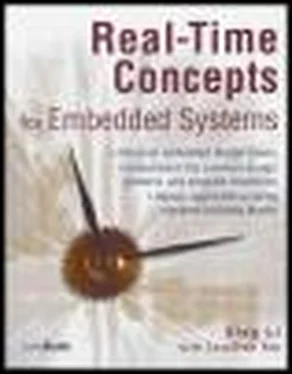As Chapter 5 discusses, in an embedded operating system environment, all task objects have a task control block (TCB). During task creation, a block of memory is reserved as a stack for task use, as shown in Figure 10.4. High-level programming languages, such as C and C++, typically use the stack space as the primary vehicle to pass variables between functions and objects of the language.
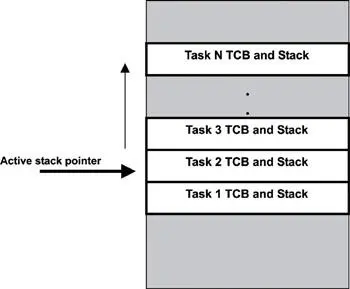
Figure 10.4: Task TCB and stack.
The active stack pointer (SP) is reinitialized to that of the active task each time a task context switch occurs. The underlying real-time kernel performs this work. As mentioned earlier, the processor uses whichever stack the SP points to for storing its minimum state information before invoking the exception handler.
Although not all embedded architectures implement exception or interrupt processing in the same way, the general idea of sizing and reserving exception stack space is the same. In many cases, when general exceptions occur and a task is running, the task's stack is used to handle the exception or interrupt. If a lower priority ESR or ISR is running at the time of exception or interrupt, whichever stack the ESR or ISR is using is also the stack used to handle the new exception or interrupt. This default approach on stack usage can be problematic with nested exceptions or interrupts, which are discussed in detail shortly.
10.5.3 Loading and Invoking Exception Handlers
As discussed earlier, some differences exist between an ESR and an ISR in the precursory work the processor performs. This issue is caused by the fact that an external interrupt is the only exception type that can be disabled by software. In many embedded processor architectures, external interrupts can be disabled or enabled through a processor control register. This control register directly controls the operation of the PIC and determines which interrupts the PIC raises to the processor. In these architectures, all external interrupts are raised to the PIC. The PIC filters interrupts according to the setting of the control register and determines the necessary action. This book assumes this architecture model in the following discussions.
Formally speaking, an interrupt can be disabled, active, or pending. A disabled interrupt is also called a masked interrupt . The PIC ignores a disabled interrupt. A pending interrupt is an unacknowledged interrupt, which occurs when the processor is currently processing a higher priority interrupt. The pending interrupt is acknowledged and processed after all higher priority interrupts that were pending have been processed. An active interrupt is the one that the processor is acknowledging and processing. Being aware of the existence of a pending interrupt and raising this interrupt to the processor at the appropriate time is accomplished through hardware and is outside the concern of an embedded systems developer.
For synchronous exceptions, the processor first determines which exception has occurred and then calculates the correct index into the vector table to retrieve the ESR. This calculation is dependent on implementation. When an asynchronous exception occurs, an extra step is involved. The PIC must determine if the interrupt has been disabled (or masked). If so, the PIC ignores the interrupt and the processor execution state is not affected. If the interrupt is not masked, the PIC raises the interrupt to the processor and the processor calculates the interrupt vector address and then loads the exception vector for execution, as shown in Figure 10.5.
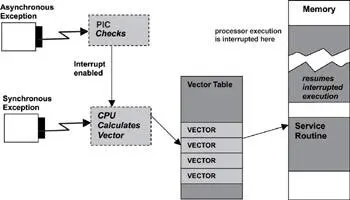
Figure 10.5: Loading exception vector.
Some silicon vendors implement the table lookup in hardware, while others rely on software approaches. Regardless, the mechanisms are the same. When an exception occurs, a value or index is calculated for the table. The content of the table at this index or offset reflects the address of a service routine. The program counter is initialized with this vector address, and execution begins at this location. Before examining the general approach to an exception handler, let's first examine nested interrupts and their effect on the stack.
10.5.4 Nested Exceptions and Stack Overflow
Nested exceptions refer to the ability for higher priority exceptions to preempt the processing of lower priority exceptions. Much like a context switch for tasks when a higher priority one becomes ready, the lower priority exception is preempted, which allows the higher priority ESR to execute. When the higher priority service routine is complete, the earlier running service routine returns to execution. Figure 10.6 illustrates this process.
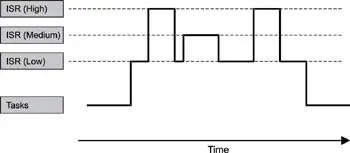
Figure 10.6: Interrupt nesting.
The task block in the diagram in this example shows a group of tasks executing. A low-priority interrupt then becomes active, and the associated service routine comes into context. While this service routine is running, a high-priority interrupt becomes active, and the lower priority service routine is preempted. The high-priority service routine runs to completion, and control returns to the low-priority service routine. Before the low-priority service routine completes, another interrupt becomes active. As before, the low-priority service routine is preempted to allow the medium-priority service routine to complete. Again, before the low-priority routine can finish, another high-priority interrupt becomes active and runs to completion. The low-priority service routine is finally able to run to completion. At that point, the previously running task can resume execution.
When interrupts can nest, the application stack must be large enough to accommodate the maximum requirements for the application's own nested function invocation, as well as the maximum exception or interrupt nesting possible, if the application executes with interrupts enabled. This issue is exactly where the effects of interrupt nesting on the application stack are most commonly observed.
As exemplified in Figure 10.4, N tasks have been created, each with its own TCB and statically allocated stack. Assuming the stack of the executing task is used for exceptions, a sample scenario, as shown in Figure 10.7, might look as follows:
1. Task 2 is currently running.
2. A low-priority interrupt is received.
3. Task 2 is preempted while exception processing starts for a low-priority interrupt.
4. The stack grows to handle exception processing storage needs.
5. A medium-priority interrupt is received before exception processing is complete.
6. The stack grows again to handle medium-priority interrupt processing storage requirements.
7. A high-priority interrupt is received before execution processing of the medium interrupt is complete.
8. The stack grows to handle high-priority interrupt processing storage needs.
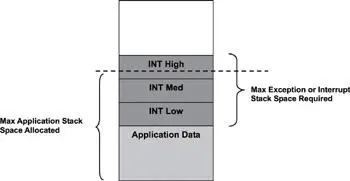
Figure 10.7: Nested interrupts and stack overflow.
In each case of exception processing, the size of the stack grows as has been discussed. Note that without a MMU, no bounds checking is performed when using a stack as a storage medium. As depicted in this example, the sum of the application stack space requirement and the exception stack space requirement is less than the actual stack space allocated by Task 2. Consequently, when data is copied onto the stack past the statically defined limits in this example, Task 3's TCB is corrupted, which is a stack overflow . Unfortunately, the corrupted TCB is not likely to be noticed until Task 3 is scheduled to run. These types of errors can be very hard to detect. They are a function of the combination of the running task and the exact frequency, timing, and sequence of interrupts or exceptions presented to the operating environment. This situation often gives a user or testing team the sense of a sporadic or flaky system. Sometimes, dependably recreating errors is almost impossible.
Читать дальше
